Serendip is an independent site partnering with faculty at multiple colleges and universities around the world. Happy exploring!
BSIE 2010: Session 7

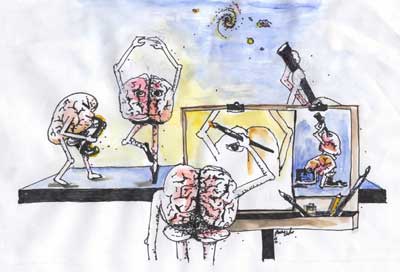 |
Brain, Science, and Inquiry-Based Education
|
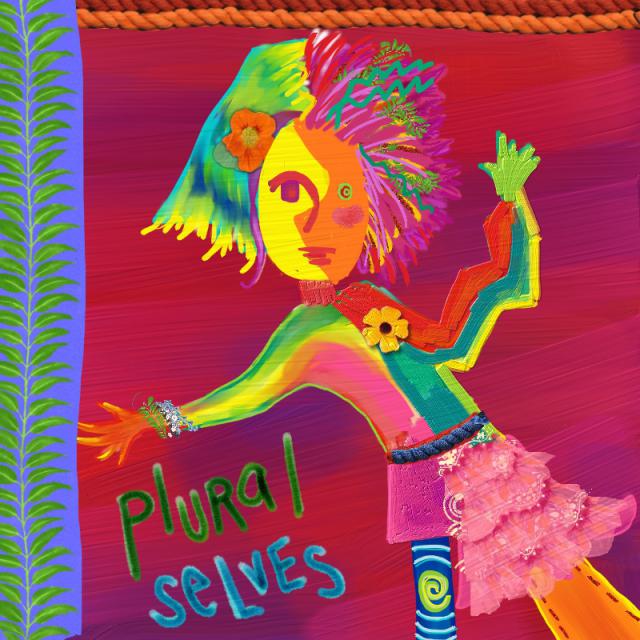 |
Picking up from yesterday
All students should be encouraged to be part of the open conversation; they should feel safe and comfortable expressing all their ideas. The student needs to know that the teacher is not the final authority, we are all still learning and searching for answers together. If we teach something new and the student asks why they need to learn it, we will answer that this information will help them in the future and that the learning process is a collaborative thing between the student and teacher ... Shoshana
As I learn and grow in the art of conversation, there are a few areas that I know I must grow in, in order to get the most out of what others are saying. I have been working on the development of my listening skills. It can be challenging for me to listen and process what others say to get the full value of their words. When I hear something that I agree/disagree with I want to jump in and make a comment without fully listening to the rest of what is being said ... Ashley (see also Susan, Paul, Jack)
It used to fill me with trepidation to think there is no “Truth”. Is it possible to make sense out of daily living, as well as understanding the world around me if there is nothing truly true? Now, after several Summer Institutes I am able to accept this notion. However, I need the realization that this concept is not practical for everyday living. Einstein can declare that there is no such thing as gravity. That does not mean that I should step out of a third floor window to leave my house. I need to incorporate my own perceptions and belief systems, common sense and generally accepted “facts” to interact with the world ... Regina
I never looked upon science as being 'creative' but it is in that it allows us to create, view, write, and experience various observations and summary's. Can we now agree or say that creativity encompasses all scientific thought and to an extent cultural understanding? Are we all that creative? ... cdivo39
I don't profess to be the best science teacher they will ever have, but I will give them multiple opportunities to discover science through hands on exploration. Does all science have other conclusions? If you put Keith's cup of water into a freezer, you can't dispute that the liquid becomes a solid, or that that frozen solid is called ice. You can make many other observations about that cup of ice, but what other summary can you come to regarding what happened to the water ... isn't some science definite, and can't be described any further? ... Jack
What I think was nearly implied but not fully discussed was the role that culture plays on the construction of truth. It appears to me that these are a part of a larger cycle, both playing on each other. In some instances we define observations as "truth" or being true in order to make it fit comfortably in our cultural reality ... When a new idea....or set of observations if you will...come about and society/cultural entities want to adopt them, culture is then defining what we see as true. I think this is extremely important as an idea as we see the expanding diversity of our classrooms. I feel that it is important that we learn to embrace this idea as we try to be more diverse in our own ideas and styles as teaching as well as simply just being human ... Keith
When he opened the create of eggs I had a Ah-Ha moment I then thought that as much as things look a like that is just how much they are different ... Kim
Diversity is initiated by change; scientists study diversity to search for the agents of change. In this manner we might develop a pattern of historical perspective which identifies the catalysts involved ... Joyce
It was my experience in the past several years that I taught in West Philadelphia that these children are at a disadvantage because they do not have the same opportunities as do students just across City Line Avenue. But what I discovered after teaching this past year is that these students should not be catagorized in this way at all. Their lives are very different from my children's, but their culture has much value to it ... Jack
just because multiple things belong to the same category, they can always be differentiated and should be treated as individuals. This is how teachers should treat their students, as individuals. Each one is unique and special, and brings their own culture, experiences and talents to the classroom ... Shoshana
Evolution, con.
The driving force is not adaptation. The driving force is trying new things out to see what works. Order emerges from randomness interacting with selection, and is itself constantly evolving. Diversity is an essential element of evolution, the continuing exploration of what might be.
The brain as a generator of empirical knowledge: diversity, con.
- Emily Dickinson (1830-1886)
- Francis Crick, 1995: The Astonishing Hypothesis: "a person's mental activities are entirely due to the behavior of nerve cells ... and the atoms, ions, and molecules that make them up and influence them".
- V.S.Ramachandran, 2003: " it never ceases to amaze me that all the richness of our mental life - all our feelings, our emotions, our thoughts, our ambitions, our love life, our religious sentiments and even what each of us regards as his own intimate private self - is simply the activity of these little specks of jelly in your head, in your brain. There is nothing else"
- Paul Grobstein, contemporary: "Brain = behavior, there isn't anything else."
- Behavior can be altered by altering the nervous system
- Traumatic brain damage
- Surgery, drugs, and ... ?
- Epilepsy as an instance
- Lots of aspects have behavior, even quite sophisticated ones, have "material" feel about them
- Surprising and quite sophisticated things can emerge from interactions of simple elements (of which the brain/nervous system is an example, as we'll see).
- It isn't that anything "disappears" as one discovers things related to the brain but rather that the Brain gets "wider"
- Disadvantages?
- Advantages:
- we can ourselves create new understandings of the world, individually and collectively
- would make the unobservable (the unconscious) observable?
The "real" nervous system - different if behavior different?
- Among different kinds of organisms?
- Among different individuals? within individuals over time? - New imaging techniques
- Notice that differences leave open the question of what causes differences (genes, experiences, activity, culture, etc)
- Implies that "information" can alter matter; not mysterious, "info" turns out to be perturbations of matter organization in neurons, can via metabolic processes influence organization/properties of neurons
- Why the diversity? Is there a "best" nervous system or .... ?
The brain itself as an explorer/creator
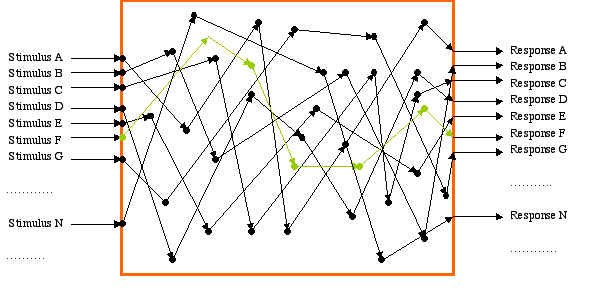 |
The sphaghetti (switchboard, "reflex") box model
Virtues
|
Problems of reflex model
Harvard Law of Animal Behavior
"Under carefully controlled experimental circumstances, an animal will behave as it damned well pleases"
Divergence and convergence
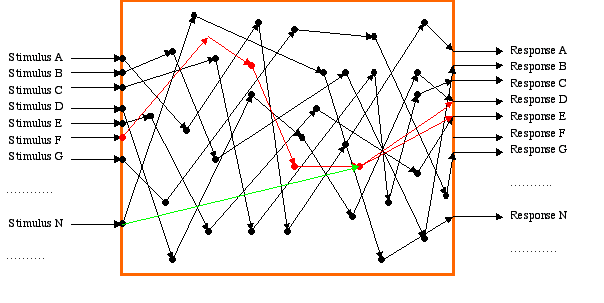 |
Sphaghetti (switchboard, "reflex") plus box model
Virtues
|
A rethinking - boxes in boxes
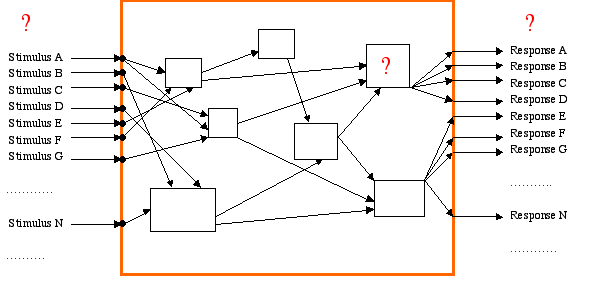 |
The sphaghetti (switchboard, "reflex") box model
Virtues
|
Facing up to the stereotopy, stimulus-response problem ... freeing the box from the outside world, adding autonomy


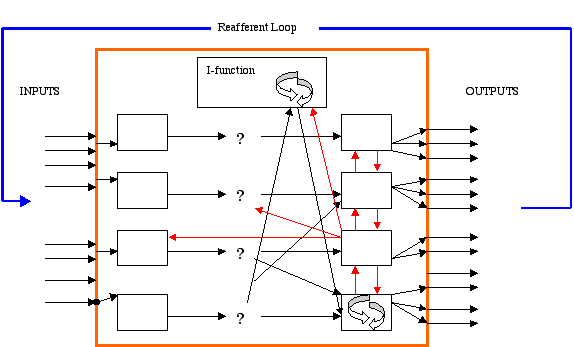
Diversity from combination/organization - every brain an exploration of possibilities

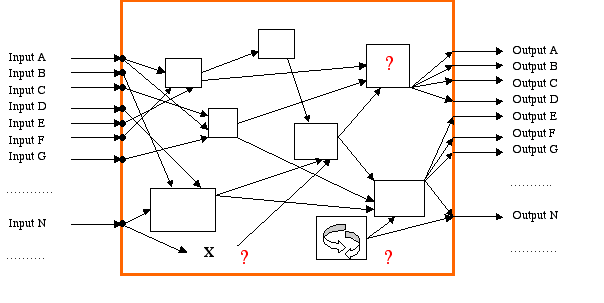


Comments
Randomness in the Nervous System
I am fascinated by the idea of the ancestral random noise in all nervous systems. This is similar to mutations giving evolution the means of change and therefore diversity. In addition, we also see the diversity of human brains perhaps fed by this randomness element. It’s so interesting that there is this mechanism with which we have no control or awareness.
Adjust Teaching to EACH Mind
Great reference Keith! Particularly this section:
"But my mother says a teacher has to be adjusted to fit the mind of each boy and girl it teaches and that each kid has to be taught differently."
I think that his is exactly what most of us strive for as teachers!
Session7
Each of us has probably been in a group setting where there was one member who dominated the conversation or discussion, while in the same group was asecond member who said nothing throughout the entire meeting. Sometimes it is never known or revealed why this is the case. Perhaps, as educators, we should be just as concerned about the student who is fixated on monopolizing the conversation or discussion, similar to way we are concerned about that student who appears to be fixated on making no comment at all. The "talker" may not be open about ,or aware as to why he has the need to dominate, while the non-talker may not be aware of just what is needed to make him feel more as an active talking participant within the group. Changes are needed by both.
1st Thursday AM
Thanks Shoshana…learning is a collaboration between students and their teachers.
Thanks Susan, learning is collaboration, also, between the students themselves. Often, they learn quicker and better from their peers; it’s easier if you will.
Train up a child in the way they should go, and when they are old they will not depart from it {Proverbs 22:6}. Family provides initial communication skills, or the lack there of. Meal time, especially dinner, was also conversation time and a time for everyone to catch up on what everyone is feeling and doing. Now the family routinely does not eat together and tend to communicate non-verbally, but via electronic devices. As wonderful and wonder filled as they are, they have sabotaged our family unit, among other essential aspects of our life…including, but not limited to, aided in job lost for humans.
I think this is a great
I think this is a great quote.
"However, drawing their thoughts is great, but it does not build solid writing skills, spelling, and grammar; all of which is essential for success in society and is the most acceptable form of communication."
I think the idea in writing is to give them the tools they need to communicate as effectively as possible. I think your quote relates directly to the idea of context specific and context association that we have been talking about. It is our job to try to educate them on the appropriate time to do such types of expressive writing and when it is appropriate to be more formal. The question I believe we have all been working on is "when should we be doing it one way or another?" I say "doing it" to be intentionally vague to illustrate that this could be said for anything and everything we ever do. Great post!
Establish Conversation Through Relationship
We spent quite some time discussing conversation today. The topic of students who were unwilling to conversate was brought up, among other things. I thought it was interesting how Paul described this as not being "normal" and that they are being inhibited by something. I have been reflecting on some of my students. One thing that I feel is important is to establish relationships and safety in the classroom. One way I do this is to find an opportunity to see them in an activity outside of my classroom. I go to dances, sporting events, homecoming, anything to see them in a different environment. I like to see my students in different contexts. This seems to help establish relationships. I feel forming relationships with my students is very important. Walls come down...
Evolution through randomness
I have been teaching selection and adaptation as the driving forces of evolution. When we are discussing the electron transport chain my senior biology students ask how did the electron acceptors get in this order of increasing electronegativity. My answer is always that these molecules did not get in the order nor were they placed in this order, rather the order was an accident of trying different possibilities. The arrangement we see now is the one that worked. We don't know how many different variations existed that did not survive. After this morning's discussion about Paul's story of evolution being change, diversity, and explanation, I plan to change my approach to their questions. The evolution challenge game created an aha moment for me that sent shivers through my brain- yes, I felt them!
In October, when we study cellular respiration, I will be ready. Mitochondrial organization, as we see it now, came out of randomness. The electron acceptors developed through a system of randomness leading to diversity. The environment, fine and coarse, selected for certain acceptors. The acceptors embedded in the inner mitochondrial membrane randomly into a diversity of arrangements. The arrangement that lead to the most opportunities for the creation of a proton gradient to drive the phosphorylation of ADP into ATP and result in the source of kinetic energy that permitted cell work for life was selected for until adaptation eliminated diversity into the arrangement of electron acceptors by increasing electronegativity. The need for a large energy source in a eukaryotic cell was the selective pressure that reduced diversity and resulted in order.
The class will then take the environmental challenge. The students will see the randomness leading to diversity. We will impose a selective pressure so that the students can see that adaptation will reduce diversity. Next we will participate in the National Geographic Genographic Project. We will compare our individual results to again see that the diversity of human life that migrated out of Africa was selected upon by the different environments into which people travelled. The different environments put selective pressure on the migrating groups that caused adaptations with a resulting decrease in diversity. It was the reduction in diversity that resulted in a unique genetic marker for humans in each path of migration. The uniqueness of these markers permitted the tracing of humans as they populated the Earth.
A new idea for next year's biology discussion. Thanks, Paul.
You said a mouthful
Wow! What a post. That is hard to follow up. I think what you are discussing could use a great lead in activity....like I don't know....looking at eggs. Ha ha. What I get out of our group discussion and your post on this idea of randomness is that no matter what the situation is, and how similar things may appear to be, there will always be variation. That even with environmental restrictions, randomness will always exist.
The Future of Teaching
I decided to write today in the forum about the future implications of technology in education and its relationship with culture due to a discussion that Ashley and I were having about her teaching in cyber school. One of the thoughts that I had was directly related to Isaac Asimov's (1920-1992) story "The Fun They Had" that is based on the concept of cyber school in 2157 and was written in 1952. Being somewhat of a visionary, Asimov explicitly points out some of the cultural affects this could have.
"
So she said to Tommy, "Why would anyone write about school?"
Tommy looked at her with very superior eyes. "Because it's not our kind of school, stupid. This is the old kind of school that they had hundreds and hundreds of years ago." He added loftily, pronouncing the word carefully, "Centuries ago."
Margie was hurt. "Well, I don't know what kind of school they had all that time ago." She read the book over his shoulder for a while, then said, "Anyway, they had a teacher."
"Sure they had a teacher, but it wasn't a regular teacher. It was a man."
"A man? How could a man be a teacher?"
"Well, he just told the boys and girls things and gave them homework and asked them questions."
"A man isn't smart enough."
"Sure he is. My father knows as much as my teacher."
"He can't. A man can't know as much as a teacher."
"He knows almost as much, I betcha."
Margie wasn't prepared to dispute that. She said, "I wouldn't want a strange man in my house to teach me."
Tommy screamed with laughter. "You don't know much, Margie. The teachers didn't live in the house. They had a special building and all the kids went there."
"And all the kids learned the same thing?"
"Sure, if they were the same age."
"But my mother says a teacher has to be adjusted to fit the mind of each boy and girl it teaches and that each kid has to be taught differently."
I think this interaction between the characters makes several interesting points. First, what are the socialization implications for children in such a setting, what implications are there for the idea that technology is an "authority" of knowledge, and is it possible that it is easier to "adjust" the teacher in a technologically run classroom than a human teacher? Social ideas, stereotypes, norms, and values are culturally constructed. This being the case, I feel that it is extremely interesting to consider the implications for learning and information gathering that such a setting will create.
Post new comment